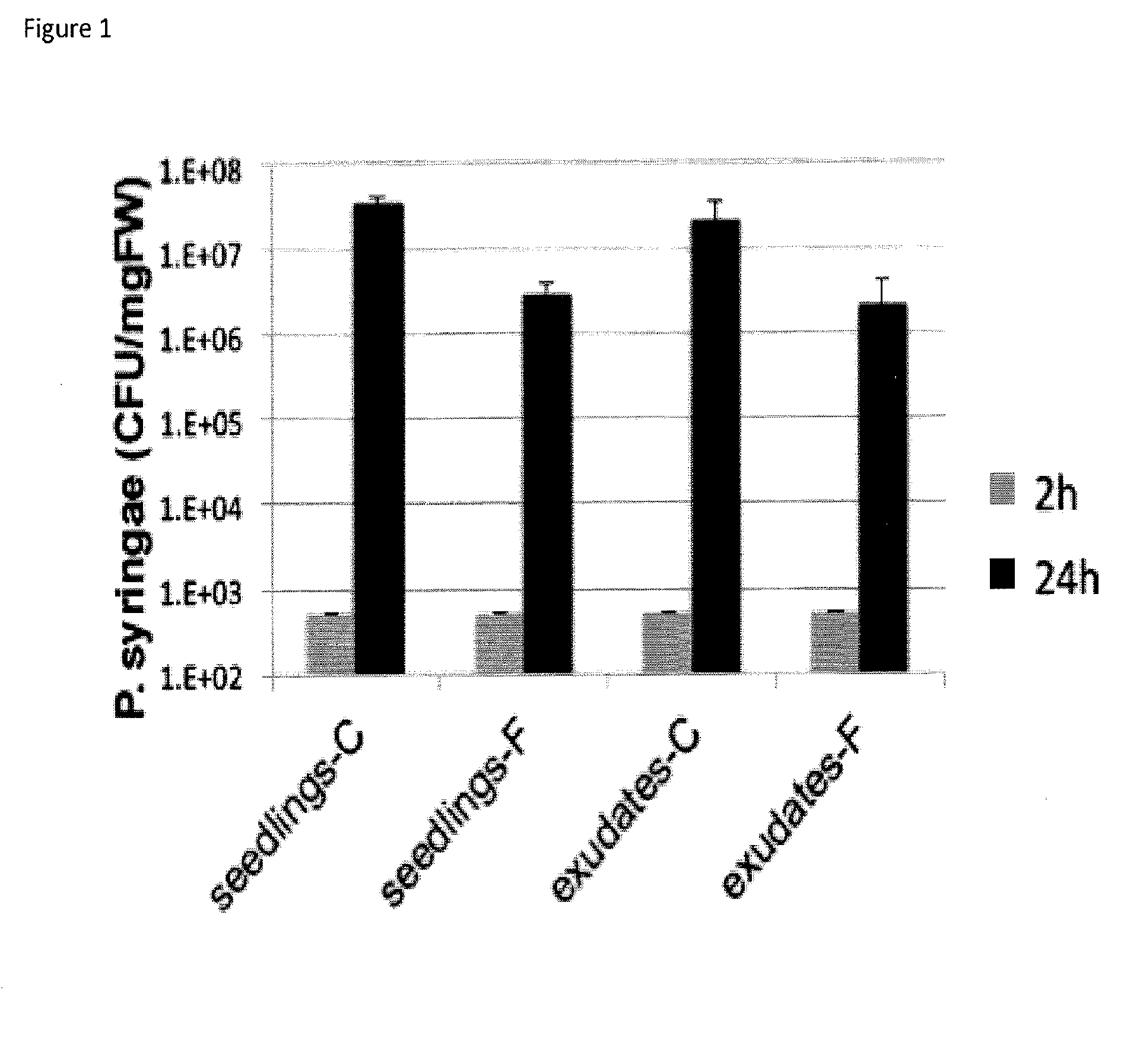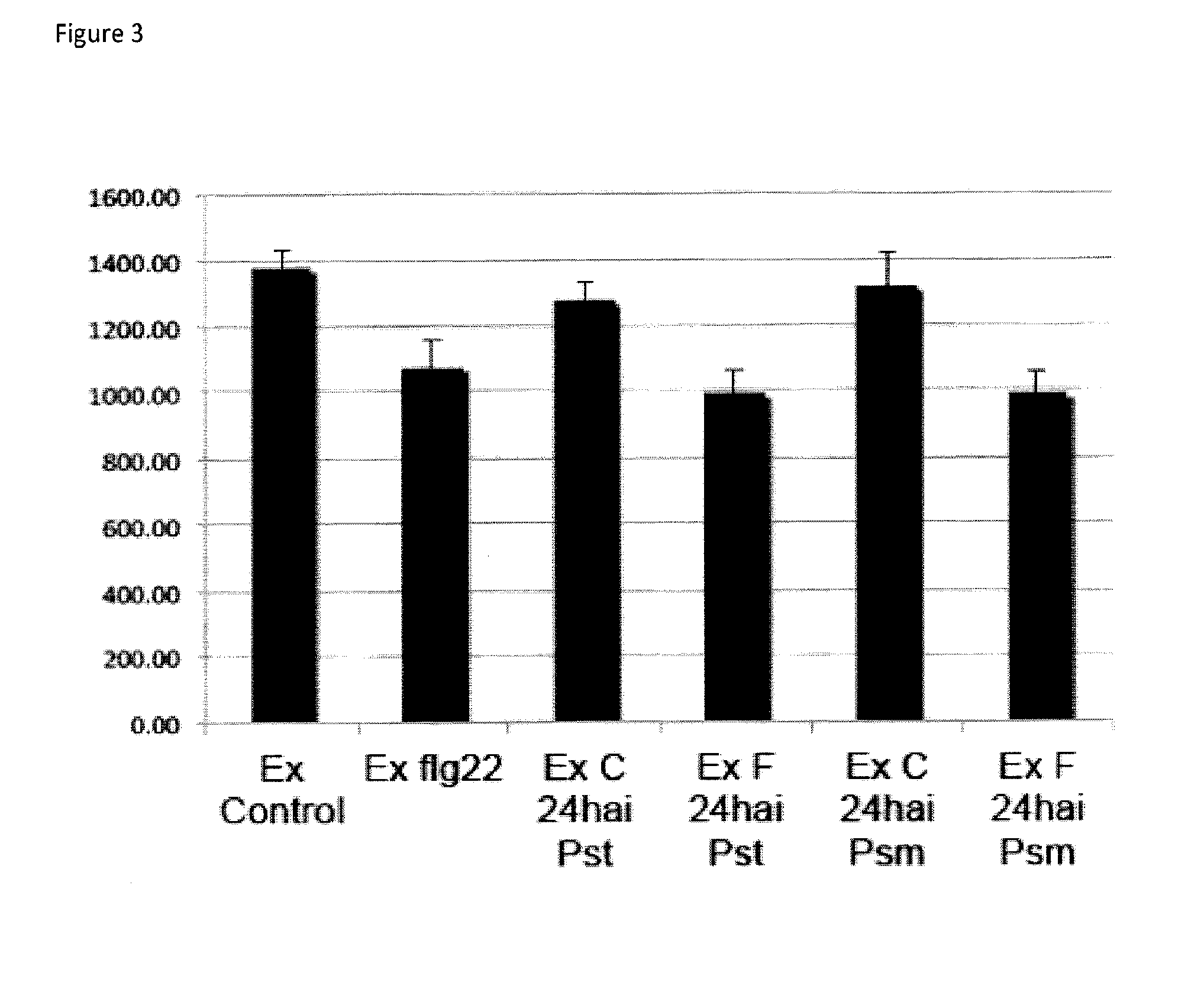Pathogen resistant plant cells and methods of making
a technology of plant cells and resistance, applied in the field of genetically modified plant cells, can solve the problems of reducing the ability of pathogens to grow and propagate, and achieve the effects of increasing or decreasing expression or activity, and increasing or decreasing activity
- Summary
- Abstract
- Description
- Claims
- Application Information
AI Technical Summary
Benefits of technology
Problems solved by technology
Method used
Image
Examples
example 1
[0107]Most studies of the plant response to either pathogens or microbe-associated molecular patterns (MAMPs) have been carried out using either mature plants or plant tissue culture cells. To provide an alternative system to facilitate the study of defense signaling pathways, an Arabidopsis thaliana model was developed that utilizes ten-day old Arabidopsis seedlings treated with MAMPs including the synthetic flagellin peptide Flg22 or that utilizes ten-day old Arabidopsis seedlings infected with bacterial pathogens in multi-well plates. Using this system studies were performed to determine the mechanisms by which seedlings can be elicited to become resistant to bacterial infection. See Clay, N. K., et al., Science, 323:95-101 (2009); Danna, C. H., et al., Proc Natl Acad Sci USA, 108:9286-9291 (2011); Denoux, C., R. et al., Characterization of Arabidopsis MAMP response pathways, In M. Lorito, et al., (eds.), Biology of Plant-Microbe Interactions, vol. 6. International Society of Mol...
example 2
[0114]In most environments, the nutrient that is most limiting to pathogen survival in plants is nitrogen, not carbon. To test whether Flg22 treatment of seedlings affected the levels of nitrogen-containing amino acids in the exudates, HPLC analysis using individual amino acids as standards was performed. As shown in FIG. 5, Flg22 treatment resulted in a significant decrease in the levels of several amino acids in the exudates, gluthamate among others. The addition of glutamate to flg22-treated seedlings, allowed Pst to grow (FIG. 6) to almost the same extent as it does on control mock treated seedlings. In addition, several amino acids suppressed the restriction of bacterial growth elicited by Flg22 in both exduates (FIG. 7) and in seedlings (FIG. 8). The data in FIGS. 5-8 demonstrate that Flg22 treatment of seedlings resulted in either the sequestering or uptake of amino acids or the suppression of amino acid secretion, or both mechanisms at the same time, which directly resulted ...
example 3
[0115]Flg22 treatment resulted in the up regulation of genes that encode transporters involved in the uptake of amino acids and sugars. For example, MATE transporters, which are involved in the efflux of compounds from cells, such as MtN21, (as well as other potential transporters) are involved in conferring resistance to pathogens by a nutrient withdrawal mechanism. A review of published genes identified several known glucose transporters and several putative amino acid transporters that are up or down regulated transcriptionally after Flg22 perception. In several specific embodiments, the genes listed in Table 1 below can be used in the methods and plant cells of the present invention.
[0116]Among amino acid transporter-encoding genes, three families were identified with members showing transcriptional up or down regulation after Flg22 elicitation: (1) genes encoding amino acid transporters belonging to the Medicago truncatula nodulin 21 (Eama-like transporters)(“MtN21”), (2) genes...
PUM
| Property | Measurement | Unit |
|---|---|---|
| pathogen resistance | aaaaa | aaaaa |
| HPLC | aaaaa | aaaaa |
| concentration | aaaaa | aaaaa |
Abstract
Description
Claims
Application Information
 Login to View More
Login to View More - R&D
- Intellectual Property
- Life Sciences
- Materials
- Tech Scout
- Unparalleled Data Quality
- Higher Quality Content
- 60% Fewer Hallucinations
Browse by: Latest US Patents, China's latest patents, Technical Efficacy Thesaurus, Application Domain, Technology Topic, Popular Technical Reports.
© 2025 PatSnap. All rights reserved.Legal|Privacy policy|Modern Slavery Act Transparency Statement|Sitemap|About US| Contact US: help@patsnap.com



